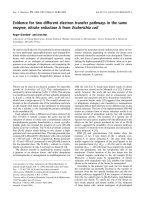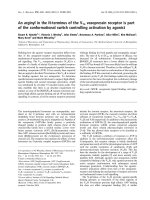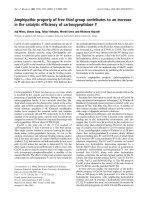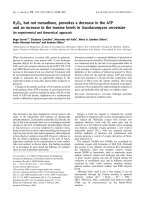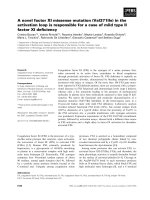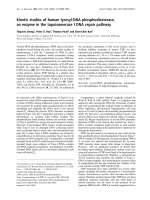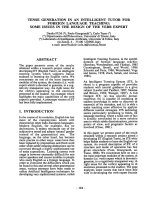HELEN HỌC CÙNG_ For Ref _Sejong University_Strategy an Organization in the international Firm
Bạn đang xem bản rút gọn của tài liệu. Xem và tải ngay bản đầy đủ của tài liệu tại đây (1.81 MB, 45 trang )
International Business
by
Prof. Yong-Sik Hwang
Sejong University
Sun Tzu
What Is Strategy?
A planned set of actions that managers take to
make best use of the firm’s resources and core
competences to gain a competitive advantage
• When developing strategies, managers examine
the firm’s strengths and weaknesses, and the
opportunities and challenges facing the firm.
• They then decide which customers to target, what
product lines to offer, how best to contend with
competitors, and how generally to configure and
coordinate the firm’s activities around the world.
International Strategy
• Strategy carried out in two or more countries
• Managers develop international strategies to:
Allocate scarce resources and configure valueadding activities on a worldwide scale
Participate in major markets
Implement valuable partnerships abroad
Engage in competitive moves in response to
foreign rivals
Global, Sustainable Competitive Advantage
• Managers should aim to “…develop, at one and the
same time, global scale in efficiency, multinational
flexibility, and the ability to develop innovations and
leverage knowledge on a worldwide basis.”
• Thus, the firm that aspires to become a globally
competitive enterprise should simultaneously strive
for three strategic objectives:
– Efficiency
– Flexibility
– Learning
Three Strategic Objectives
• Efficiency: Lower the cost of the firm’s operations
and activities on a global scale
• Flexibility: Manage diverse country-specific risks
and opportunities by tapping resources in individual
countries and exploiting local opportunities
• Learning: Develop the firm’s products,
technologies, capabilities, and skills by internalizing
knowledge gained from international ventures
• Often, even successful firms excel at only one or
two of these objectives.
Key Dimensions of
Successful International Firms
Visionary Leadership
A quality of senior management that provides
superior strategic guidance for managing efficiency,
flexibility, and learning
1. International mindset and cosmopolitan values: Openness to,
and awareness of, diversity across cultures
2. Willingness to commit resources: Financial, human, and other
resources
3. Strategic vision: Articulating what the firm wants to be in the future
and how it will get there
4. Willingness to invest in human assets: Emphasizing the use of
foreign nationals, promoting multi-country careers, and training to
develop international “supermanagers”
Examples of Visionary Leaders
• Ratan Tata, chairman of the Tata Group, oversees
a $63 billion family conglomerate whose
companies market a range of
products, from cars to watches.
• His group made numerous
international acquisitions,
reflecting a change in strategic
vision from local to global.
• Recently, Tata developed a
$2,500 car, the Nano, targeted
to emerging markets worldwide.
Organizational Culture
The pattern of shared values, behavioral norms,
systems, policies, and procedures that employees
learn and adopt
•
•
•
Employees acquire the culture as the correct way to
perceive, think, feel, and behave in relation to new
problems and opportunities that confront the firm.
Usually derives from the influence of founders and
visionary leaders or some unique history of the firm.
Management should seek to build a global organizational
culture, key to the development and execution of
successful international strategy.
Firms with a Global Organizational Culture:
• Value and promote a global perspective in all
major initiatives
• Value international competence and cross-cultural
skills among their employees
• Adopt a single corporate language for business
communication
• Promote interdependency between headquarters
and subsidiaries
• Subscribe to appropriate ethical standards
Organizational Processes
Managerial routines, behaviors, and mechanisms
that allow the firm to function as intended
• Typical processes include mechanisms for
collecting information, ensuring quality control in
manufacturing, and maintaining effective payment
systems.
• General Electric acquired competitive advantage by
emphasizing countless superior processes. GE
digitizes all key documents and uses intranets and
the Internet to automate activities and cut operating
costs.
Important Organizational Processes
for Achieving International Coordination
•
Global teams: Internationally distributed groups of
employees charged with specific problem-solving or
best practice mandates that affect the entire firm.
•
Global information systems: Global IT
infrastructure, together with tools like intranets and
electronic data interchange, provide virtual
interconnectedness within the international firm.
•
Because the processes of the international firm may
operate across numerous countries, they must
function especially well.
Multidomestic Industry
An industry in which competition takes place on a
country-by-country basis
• Firms that specialize in such industries as
processed food, consumer products, fashion,
retailing, and publishing usually cater to specific
conditions in each country where they do business.
• In such industries, the firm must adapt its offerings
to suit the language, culture, laws, income level,
and other specific characteristics of each country.
• Each country tends to have a unique set of
competitors.
Examples of Multidomestic Industries
•
•
•
The British publisher Bloomsbury has translated each
volume of its Harry Potter series into the local language in
every country where the books are sold.
Beverage companies produce various brands and flavors in
markets worldwide. Coca-Cola offers “Georgia Coffee” in
Japan, “Café Zu” in Thailand, “Inca Cola” in Peru, and “Burn”
energy drink in France.
In Asia, KFC restaurants are
often multi-story structures
that sell distinctive flavors of chicken.
Global Industry
An industry in which competition is on a regional or
worldwide scale
•
•
•
Firms that specialize in such industries as aerospace,
cars, computers, chemicals, and industrial equipment,
typically cater to customers on a regional or global
scale. For example, Subaru markets similar cars
worldwide.
In such industries, customer needs vary little from
country to country. Firms sell relatively standardized
offerings across entire regions or throughout the world.
The industry usually has only a handful of the same
competitors that compete regionally or worldwide.
Examples of Global Industries
•
•
•
Kodak must contend with the same rivals, Japan’s Fuji and
the European multinational Agfa-Gevaert, wherever it does
business around the world.
American Standard sells similar bathroom fixtures worldwide,
competing with Toto in most major markets.
Caterpillar and Komatsu compete head-on in all major
markets, and offer similar brands of tractors.
Three Levels of Competition
Global
International
Local
Global Integration
Coordination of the firm’s value-chain activities
across multiple countries to achieve worldwide
efficiency, synergy, and cross-fertilization in order to
take advantage of similarities between countries.
•
Firms that emphasize global integration:
Make and sell standardized products and
services to capitalize on converging customer needs
and tastes
Compete on a regional or worldwide basis
Minimize operating costs by centralizing value-chain
activities and emphasizing scale economies
Local Responsiveness
Meeting the specific needs of buyers in individual
countries
•
•
Local responsiveness requires the firm to adapt to
customer needs and to the competitive environment.
Local managers are free to adjust offerings,
marketing, and practices to suit conditions in
individual markets.
When operating internationally,
firms try to strike the right balance
between global integration and
local responsiveness.
Integration-Responsiveness Framework
• Summarizes the balance that firms seek to achieve
between two basic strategic needs:
1. Integrating value-chain activities globally, and
2. Creating products and practices responsive to local
market needs.
• The main goal of firms that emphasize global
integration is to maximize the efficiency of their
value-chain activities on a worldwide scale.
• The main goal of firms that emphasize local
responsiveness is to maximize sales and market
share by being highly responsive to local needs.
Integration-Responsiveness Framework
Pressures for Global Integration
•
•
•
Seek cost reduction through economies of scale.
Concentrating manufacturing in a few advantageous
locations achieves economies of mass production.
Capitalize on converging consumer trends and
universal needs. Companies like Nike, Dell, ING, and
Coca-Cola offer products that appeal to customers
everywhere.
Provide uniform service to global
customers. Services are easiest
to standardize when firms centralize
their creation and delivery.
Pressures for Global Integration (cont.)
•
•
•
Conduct global sourcing of raw materials,
components, energy, and labor. Sourcing of inputs
from large-scale, centralized suppliers provides
economies of scale and consistent performance.
Monitor and respond to global competitors. Globally
coordinating the firm’s response to competitive threats
is more efficient and
effective.
Take advantage of global media. Firms leverage the
Internet, cross-national TV, and other global media to
advertise in many countries simultaneously.
Pressures for Local Responsiveness
•
Leverage natural endowments
available to the firm. Each country
has specific national resources and
other endowments that the
foreign firm should access.
•
Cater to local customer needs. Businesses
in multidomestic industries should adapt products,
services, and marketing to suit local customer needs.
Accommodate differences in distribution channels.
For example, Japan’s distribution system for consumer
goods is characterized mainly by small retailers.
•


